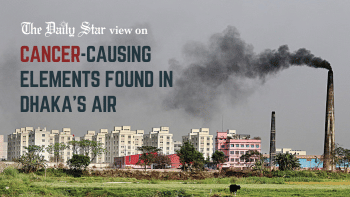Air pollution is now the biggest killer in Bangladesh

It is alarming to know that air pollution has become the leading cause of death in Bangladesh, outpacing fatalities from high blood pressure, poor diet, and tobacco use, according to a newly unveiled global study. The study found that in 2021, at least 236,000 lives were lost due to air pollution in the country. By comparison, 200,000 deaths occurred due to high blood pressure, 130,100 due to tobacco use, and 130,400 were linked to poor diet. This deserves critical attention.
Unlike other major causes of deaths, air pollution is something that affects everyone, particularly children. In fact, in 2021, the country ranked fifth globally in terms of deaths among children under the age of five due to air pollution. And as much as 36 percent of preterm births in Bangladesh were also linked to it. Aside from deaths, air pollution impacts children's health in many ways and at many levels, starting from pregnancy through early childhood. These issues may continue to affect an individual throughout their life.
Despite these severe health impacts—and the resulting burden on the nation—we wonder why the government has failed to make any significant progress in reducing air pollution. A number of previous studies have shared similar findings, which make it obvious that this has turned into a silent killer that must be urgently addressed. According to a study by Clean Air Fund (CAF), between 2017 and 2021, Bangladesh received $2.3 billion to curb air pollution. Where did this fund go? What was it used for? Does the government have any notable achievement to show that it was properly utilised?
Major pollutants like construction dust, traffic fumes, factory emissions, and brick kilns continue to be unchecked to this day. According to Bangladesh Road Transport Authority (BRTA), of the 60 lakh registered vehicles in the country, about 6.17 lakh run with no or expired fitness certificates. Additionally, Bangladesh produces about 30 lakh tonnes of e-waste every year—most of which contain carcinogenic elements. Brick kilns, too, continue to heavily pollute the environment. In other words, the government has done little to nothing to address the killer air that citizens are breathing in.
Last year, the High Court rightly lambasted the Department of Environment (DoE) for failing to take effective steps to control air pollution in Dhaka despites its repeated directives. But even that seems to have changed nothing. It is high time, therefore, for the relevant state institutions as well as polluting entities to be held responsible for their negligence or contributions in this regard. Perhaps then they will finally start to act as they are legally bound to do, and help prevent needless deaths of citizens.


 For all latest news, follow The Daily Star's Google News channel.
For all latest news, follow The Daily Star's Google News channel. 











Comments